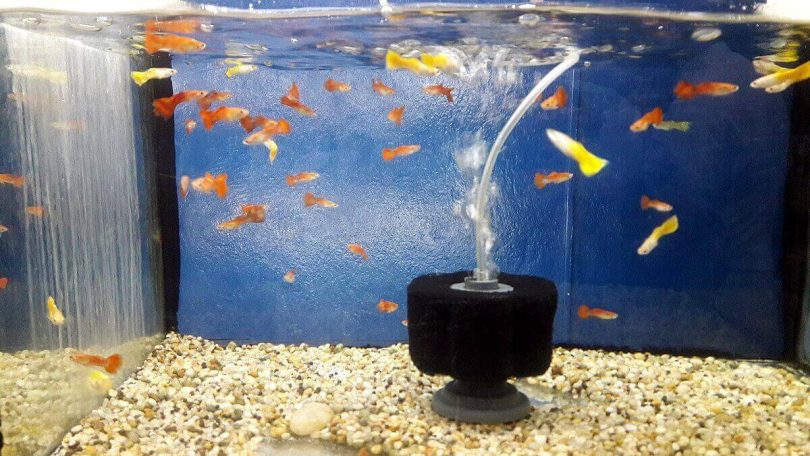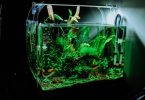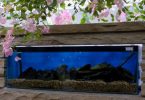Table of Contents
Setting up an aquarium is an exciting and rewarding hobby that brings the mesmerizing beauty of underwater life right into your home. Whether you’re a beginner or a seasoned aquarist, understanding the essential components of an aquarium is crucial for creating a thriving and healthy aquatic environment.
In this blog post, we’ll delve into the key components that make up a successful aquarium, from the tank itself to the various equipment and accessories that ensure the well-being of your aquatic pets.
Aquarium Tank
The very foundation of any aquarium is, of course, the tank. Choosing the right tank size is vital, and it largely depends on the available space and the type of fish you wish to keep.
A larger tank generally provides a more stable environment and allows for a greater variety of fish and plants.
When selecting the tank material, most hobbyists opt for glass or acrylic tanks. Glass tanks are sturdy, scratch-resistant, and provide better clarity, while acrylic tanks are lightweight and less prone to shattering, making them a safer choice for large setups.
Ensure that the tank has a secure and tight-fitting lid to prevent fish from jumping out and to reduce evaporation.
Water Filtration System
A reliable water filtration system is the lifeblood of any successful aquarium. It helps maintain water quality by removing impurities, excess nutrients, and harmful substances that can be detrimental to the fish and plants. There are three main types of filtration: mechanical, biological, and chemical.
- Mechanical Filtration: This stage involves the physical removal of debris and particles from the water. A sponge or a filter pad can effectively trap larger waste, preventing it from clouding the water and clogging the biological media.
- Biological Filtration: Here’s where the magic happens! Beneficial bacteria colonize the filter media and break down harmful ammonia and nitrite, converting them into less harmful nitrate. This biological cycle, known as the nitrogen cycle, is essential for a healthy aquarium.
- Chemical Filtration: While mechanical and biological filtration are usually sufficient, some aquariums may benefit from chemical filtration using activated carbon or other specialized media to remove specific impurities or medications.
Aquarium Lighting
Just like humans, plants and fish require the right amount of light to thrive. Aquarium lighting not only enhances the visual appeal of the tank but also supports the growth of live plants and helps regulate the biological processes of the fish.
When selecting aquarium lights, consider the type of aquarium you want to create: freshwater or marine, low-light or high-light, and the type of plants and fish you intend to keep.
LED lights have become increasingly popular due to their energy efficiency, long lifespan, and ability to produce different colors and intensities. They also generate less heat, reducing the risk of overheating the aquarium water.
Some LED lighting systems even come with adjustable timers, allowing you to simulate day and night cycles, which is beneficial for the fish and can prevent algae growth.
Heater and Thermometer
Maintaining a stable water temperature is crucial for the health and well-being of your fish. Different species have varying temperature preferences, so it’s essential to research the specific requirements of your fish before setting up the aquarium.
- Aquarium Heater: An aquarium heater is a device that helps regulate the water temperature to a preset level. It usually consists of a heating element encased in a glass or plastic tube that can be fully submerged in the water. Many heaters come with built-in thermostats to maintain a constant temperature, and some even have safety features to prevent overheating.
- Aquarium Thermometer: To ensure the heater is functioning correctly and the water temperature remains within the desired range, an aquarium thermometer is a must-have accessory. You can choose from traditional glass thermometers that stick to the aquarium glass or digital ones that provide more accurate readings.
Having both a reliable heater and thermometer is crucial for creating a stable and comfortable environment for your fish.
Aquarium Substrate
The substrate is the material that lines the bottom of the aquarium and serves several essential purposes. First and foremost, it provides a natural and aesthetically pleasing look to the tank.
Secondly, it serves as a home for beneficial bacteria, contributing to the biological filtration process. There are various types of substrates available, each suitable for different setups:
- Gravel: Gravel is one of the most common substrates used in aquariums. It comes in various colors and sizes, allowing for creative aquascaping. However, it’s essential to choose a size that won’t be ingested by bottom-dwelling fish.
- Sand: Sand is an excellent choice for certain fish species, especially those that like to sift through the substrate, such as catfish. It provides a more natural look and can be used in both freshwater and marine setups.
- Plant Substrate: For avid aquascapers and plant enthusiasts, a specialized plant substrate can be used to promote healthy plant growth. These substrates are rich in nutrients that support root development and overall plant health.
Aquarium Decorations
Aquarium decorations not only add visual appeal to the tank but also serve as hiding spots, play areas, and territory markers for the fish. When choosing decorations, consider the theme of your aquarium and the preferences of your fish.
- Rocks and Driftwood: Natural rocks and driftwood are popular choices as they create a more realistic and captivating underwater environment. They can also affect the water chemistry, so it’s essential to research the types of rocks and wood that are safe for your fish.
- Caves and Hideouts: Many fish species, especially cichlids, enjoy having caves or hiding spots. These decorations provide shelter and reduce stress for the fish by mimicking their natural habitat.
- Artificial Decorations: Artificial plants, castles, and other decorative elements are readily available and can be a great alternative, especially for beginners or for aquariums with fish that may uproot live plants.
Aquarium Plants
Live plants offer numerous benefits to an aquarium. They produce oxygen, absorb carbon dioxide, provide hiding spots for fish, and compete with algae for nutrients, helping to keep the tank clean and well-balanced. When choosing aquarium plants, consider the following:
- Lighting Requirements: Different plants have different light requirements. Some thrive in low-light conditions, while others require intense lighting. Match the plants to your aquarium’s lighting setup.
- Planting Method: Some plants can be rooted in the substrate, while others can be attached to rocks or driftwood. Choose plants that are compatible with your chosen substrate and aquascape design.
- Maintenance: Some plants grow rapidly and may require frequent trimming, while others are slow-growing and need minimal maintenance. Consider your time commitment for plant care.
Aquarium Fish
Of course, the stars of the show are the fish themselves! When selecting fish for your aquarium, there are several factors to take into account:
- Compatibility: Different fish species have varying temperaments and habitat preferences. Ensure the fish you choose can coexist peacefully and have similar water requirements.
- Tank Size: Consider the adult size of the fish you want to keep and provide a tank large enough to accommodate their needs comfortably.
- Schooling Fish: Some fish species prefer to be in groups, known as schools. Keeping them in proper numbers will reduce stress and create a more natural environment.
- Feeding Habits: Different fish have different feeding habits, and it’s crucial to choose fish that accept the same type of food, whether it’s flakes, pellets, or live/frozen food.
Maintenance Equipment
Regular maintenance is essential to keep your aquarium clean and your fish healthy. Here are some crucial maintenance equipment you’ll need:
- Algae Scraper: Algae can accumulate on the glass and decorations, affecting the tank’s appearance and water quality. An algae scraper or magnet cleaner makes it easy to remove algae and keep the glass clean.
- Water Siphon: Partial water changes are necessary to remove excess nutrients and waste. A water siphon makes water changes a breeze, allowing you to remove debris from the substrate and replace the water.
Fish Net
Lastly, a fish net is a simple but essential tool for safely catching and handling fish when needed. Choose a net size appropriate for your fish to avoid stressing or injuring them during handling.
Conclusion
In conclusion, setting up and maintaining an aquarium involves various components working together to create a thriving aquatic ecosystem.
From the tank itself to the filtration system, lighting, heating, substrate, decorations, plants, and the fish themselves, each component plays a vital role in the overall health and well-being of your aquarium inhabitants.
Proper research and understanding of the specific needs of your fish and plants will help you create a beautiful and harmonious underwater world that brings joy and relaxation to both you and your aquatic pets. Happy fishkeeping!







